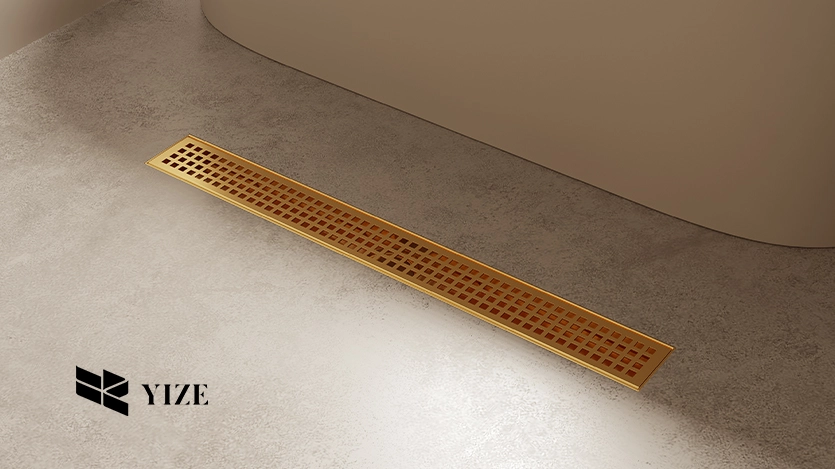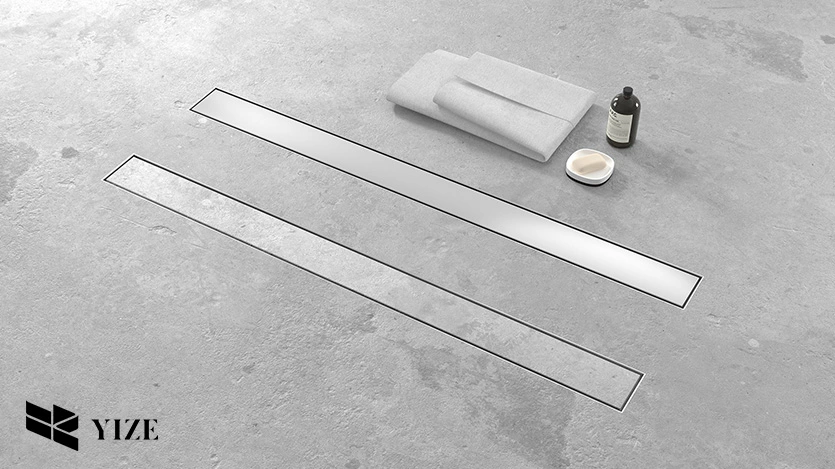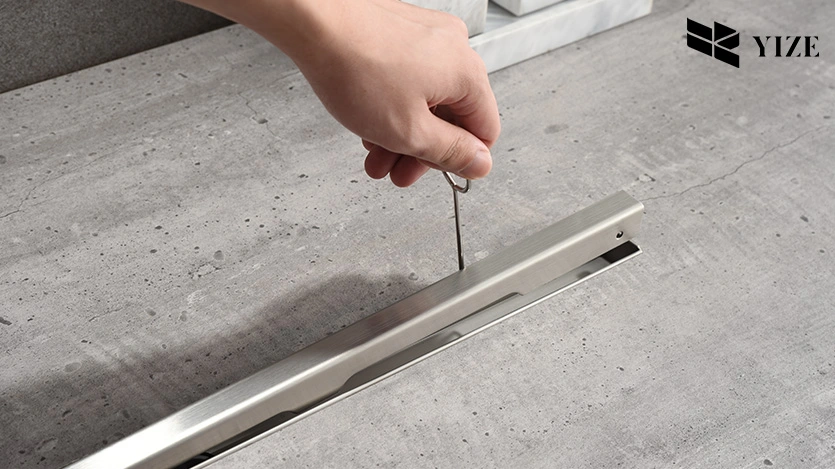
Introduction
A recessed shower drain, or linear or channel drain, is a discreet and functional method of controlling water in today’s bathroom spaces. Common shower drains are centrally positioned on the floor of the shower; recessed shower drains, on the other hand, are installed level with the floor, giving it a more streamlined look. Consumers appreciate this style because of its elegance and its ability to drain water well. In this article, you will learn all the necessary information about recessed shower drains, their advantages, how to install them in your shower, where to place the drain, and how to take care of the latter.
Understanding Recessed Shower Drains
A recessed shower drain is embedded into the shower floor, making it invisible and offering a flat surface for water to be shed. These drains can be linear or box-shaped and usually are equipped with the grating which matches the level of floor tiles. Key features include:
- An attractive and flat upon design which makes it to blend with the shower area making it beautiful.
- Enhanced water flow as well as proper drainage system.
- Strength of material and its compatibility with other floor finishes such as tiles and stones.
- Proximity to clean and facilitative access to the appliances.
Benefits of Using Recessed Shower Drains
Recessed shower drains offer several advantages over traditional drains:
- Aesthetics: They are high grade and sleek in appeal, and perfect for installation on the shower floor.
- Accessibility: Fitted to the floor, they reduce barriers that can cause falls, thus increasing the shower accessibility for not only elderlies but also for individuals with physical disabilities.
- Versatility: Versatile to accommodate a variety of shower types such as walk-in and barrier-free showers.
- Improved Drainage: The roofs’ designs enable better water drainage so that there is minimal chance of water accumulation.
Comparison with Traditional Shower Drains
Traditional shower drains are usually installed right in the middle of the shower floor and this interferes with the tile design. They usually call for a four-way slope in order to allow water to flow into the drain, and hence the system is a little more intricate. Recessed drains, however, call for only one slope hence their installation is easier than the other type of drains besides, they make the shower floor look better. Also, the recessed drains are unsusceptible to the clogging problem and are easier to maintain as compared with the visible drains that form part of most contemporary bathroom designs.
Where Should the Drain Be Placed in a Shower?
Yes, a linear drain can indeed be installed in the middle of a shower area, although the design is not very typical. Central plant location poses some difficulties for water drainage flow from all the sides towards the drain. Though it is possible, most of the experts recommend installing linear drains to either the edges or against one wall as this makes the tiling as well as draining process easier.Pros and Cons of Placing a Linear Drain in the Center
Pros and Cons of Placing a Linear Drain in the Center

Pros
- Symmetry: Can produce an equilibrium and axial appearance.
- Versatility: Ideal for big, individual showers where water has to flow in all directions depending on the users’ preference.
Cons
- Complexity: It needs more accurate fixing and tilting to avoid water accumulation throughout the surface area.
- Aesthetic Impact: It may lead to a disruption of the flow in terms of how the floor design looks like.
- Maintenance: Although central placement is advantageous, it hinders cleaning .
Optimal Drain Placement in Shower
Recessed shower drains should ideally be installed along one side of the shower or near the door. This positioning allows for:
- Easier Installation: It is easy to tile if there is only one slope that will allow water to drain through the floor channel.
- Improved Aesthetics: A special design that does not call much attention to itself but still adds to the overall aesthetics of the product.
- Better Drainage: Water drains downwards without pooling because of gravity’s naturally occurring force.
YZDRAIN shower drains are fully recessed shower drains that offer versatility and may be positioned in any location in the shower. Metro by Aqua are very popular due to their high durability, simplistic installation process, as well as beautiful finishes, making Aqua Metro a perfect fit for both freshly built bathrooms and bathroom renovations.
How to Install a Recessed Linear Shower Drain?
Here is a step-by-step guide to installing a recessed linear shower drain:
Tools and Materials Needed
- Shower Recessed Center Line Drain Kit
- Measuring tape
- Level
- Trowel
- Waterproof membrane
- Tile adhesive
- Tiles
- Grout
- Sealant
Installation Steps
- Plan the Layout: It is time to measure and mark the location for the drain which should be in line with the requirements mentioned above. Make sure the gradient of the position allows for only one slope towards the drain.
- Prepare the Floor: If some old floor covering remains, it should be ripped out and the floor surface cleaned of debris. It is also advisable to cover the surface of the roof with waterproof membrane to prevent seepage of water.
- Install the Drain Base: Place the drain base on the desired location indicated on the floor and fix it in a proper manner as recommended by the manufacturer.
- Create the Slope: Using a trowel, slope the remaining surface towards the drain towards which the water is to drain. Use a level to double check the slope so that water can drain through the structure without any difficulties.
- Apply Tile Adhesive: Apply a layer of tile adhesive on the ramp and place the tiles fixing them to the surface of the selected angle to the drain grate.
- Grout the Tiles: After the adhesive has dried apply grout and apply it over the tiles. Clean out any remaining grout by gently wiping the tiles with a wet sponge.
- Seal the Edges: To inhibit water from penetrating below the floor, use a bead of sealant and apply it on the joint of the drain.
Considerations for Recessed Shower Drain Installation
- Ensure Proper Slope: The minimum slope that can be used is 1-2% in order to facilitate efficient water drainage.
- Check for Leaks: Before completing the installation, check for leaks on the drain by rinsing it for five to fifteen minutes.
- Follow Manufacturer Instructions: Ensure you strictly adhere to the manufacturer’s instructions on how the drain should be installed.
Tips from YZDRAIN’s Installation Experts
- Measure Twice, Cut Once: In this case, precise measurements are essential when it comes to the installation process.
- Use Quality Materials: Select a good quality tile, adhesive and grout to avoid having to replace them in a few years.
- Regular Maintenance: Ensure that the drain undergoes routine inspections so that any problems can be detected early enough and dealt with in the right manner.
How to Maintain and Care for Your Recessed Shower Drain?

Cleaning and Unclogging Recessed Drains
- Regular Cleaning: Take off the drain cover and wash the interior part of the drain with a small brush and a little amount of washing soap.
- Prevent Clogs: This covers comes in handy because they have small openings through which hair and debris can be trapped.
- Unclogging: For the persistent problem of blockage, employ the plumbing snake or a combination of baking soda and vinegar.
Regular Maintenance Tips
- Inspect Regularly: Look for any signs of wear or damage such as a gap between the drain and the tiles.
- Clean Grout Lines: Ensure that you clean the grout lines and remove mold or mildew by washing with a mild bleach solution.
- Seal Tiles: Tiles and grout should be sealed again and again to ensure a protective layer that can prevent leakage.
Addressing Common Issues with Central Drains
- Water Pooling: Make sure the slope is correct and drain is clean and free from any obstruction.
- Slow Drainage: The first step you should take is to inspect the drain and ensure that it is clear of any obstructions that might be within the drain.
- Odors: Maintenance should be conducted frequently because mold and bacteria can accumulate in the drain.
Conclusion
Recessed shower drains provide a clean looking and fully functional shower drain for contemporary style bathrooms. A linear drain can be installed in the middle of a shower but installing it along one of the shower walls or at the shower entrance is usually preferable due to installation issues and more efficient drainage. Installation and maintenance are vital components that will determine the longevity and efficiency of any recessed shower drain. When selecting your recessed shower drains, look no further than YZDRAIN for quality and sophistication.
Frequently Asked Questions (FAQs)
Can a linear drain be placed in the center of the shower?
Yes, but it has to be planned correctly and it has to be sloped properly to help water drain well.
What are the advantages of using recessed shower drains?
Enhanced look, ease of access, use, and drainage.
How to take care of a recessed shower drain?
Cleaning them often, checking for cracks, and making sure that the tiles and the grout are sealed.
